
Easy No-Prep STEM Activities For Kids (Very Few Materials Needed)
Read stories how our founder Albert turned his childhood passion into CircuitMess, and get exciting DIY project ideas you can do with your kids at home for free.
Table of content
STEM stands for science, technology, engineering, and math. Big words, right?
Luckily, there are tons of fun, no-prep STEM activities that can help your kids understand these concepts in an engaging way, and maybe even fall in love with science. And all that is possible with minimal preparation and maximum excitement!
Why should you encourage kids to do a STEM challenge?
Sure, STEM activities for kids are a godsend for rainy afternoons when you're trapped indoors. But did you know that STEM projects also bring multiple benefits beyond beating boredom?
Here's what you can expect from your child participating in STEM challenges:
- Increasedproblem-solving skills: Low-prep stem activities may seem simple, but they encourage children to find creative solutions and apply critical thinking.
- Hands-on exploration of science, technology, engineering, and math: Algebra sheets aren't the only way to learn; your kid can explore STEM through practical experiments and see how the principles are applied to real life.
- Boost in self-esteem: Completing a challenge gives kids a sense of accomplishment,increasing their confidence.
- Improved collaboration skills: STEM activities for children often involve teamwork, which makes them learn how to express their ideas and listen to others.
Whether it's a rainy day or a sunny one, you can't go wrong with conducting DIY science experiments with your little one. Besides having fun, they'll acquire skills that they'll later use in the classroom, careers, and everyday life.
And if you want to invest a bit more in your kids' STEM education, a kids subscription box may easily be your best pick. Check our list of the 10 best subscription boxes you can get for your little ones!
7 fun STEM activities for your kids
We're aware that most parents don't have hours and hours for elaborate prep work. The same goes for educators looking for STEM learning ideas for their students.
This doesn't mean that your kids can't put their physics and engineering skills to the test, though.
Some basic supplies and materials found around the house can become the tools of discovery in your DIY science lab. Get ready; we'll now explore seven fun STEM activities that all kids love.
Idea #1: Build a paper bridge
The first STEM activity that we'll see is as simple as it gets. We're building a paper bridge!
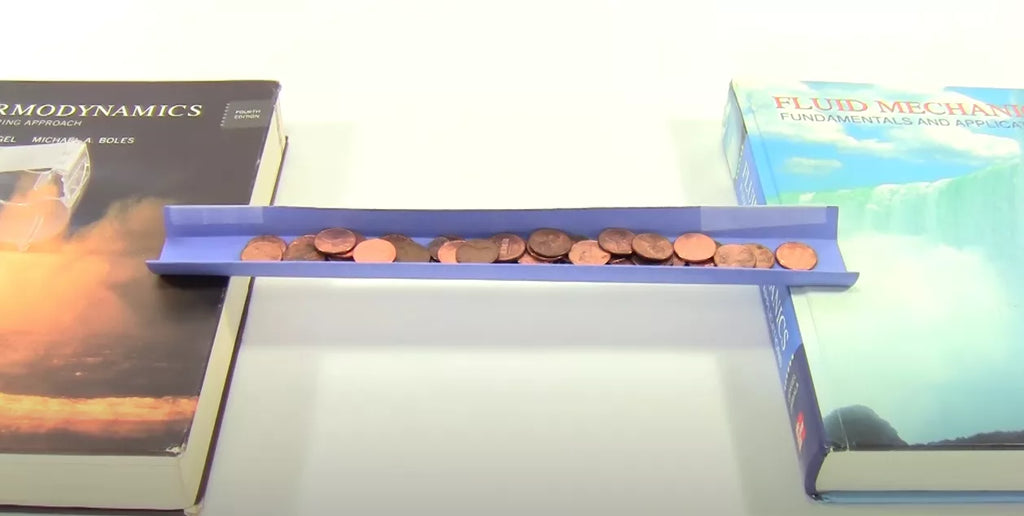
If you have a kid who's seemingly not interested in anything, they probably won't be willing to cooperate in any activity with a fancy setup—these things take effort.
Because of that, you can start with minimalistic projects that still get kids thinking, such as this paper bridge design challenge.
What equipment do you need?
You only need the following:
- Paper
- Coins
- Ruler
- Tape
- Books or small boxes
How is this useful to kids?
Who knew you could get into civil engineering with so few materials?
Jokes aside, the simple paper-bridge project can teach kids about load distribution, tension, and structural integrity in a practical manner.
It lets kids experiment with different designs and see firsthand how various factors affect the strength and stability of their bridges. Hard hats are optional!
Idea #2: Rainbow rubber egg experiment
Next on our list of no-prep stem activities for kids is the rubber egg experiment—the perfect activity for aspiring chemists with an artistic streak.
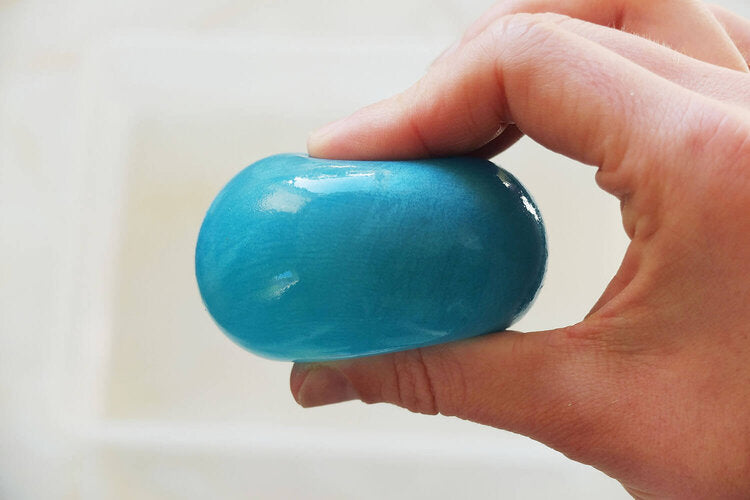
In this activity, your kid can see how basic chemical reactions and some food coloring transform an ordinary egg into a rubbery colorful ball.
What equipment do you need?
Again, you likely already have all the materials at home, and these are:
- A raw egg
- A clear jar
- Vinegar
- Food coloring
How is this useful to kids?
Creating a rubber egg helps older kids translate the abstract process of osmosis into a tangible experience. When you have a real example in front of you, the words like permeability or solvent don't sound as mysterious anymore.
For younger kids who haven't encountered such concepts in school yet, the experiment is still fun because they get to see how a solid object becomes squishy over time.
Speaking of time; although this STEM project is fairly simple, it still takes a few days to see the results, which is an excellent opportunity for your child to practice patience and focus.
And regardless of the ages of your kids, everybody likes playing with food coloring to create an array of vibrant hues.
Idea #3: Egg drop project
Do you want to challenge your kid's creativity and problem-solving skills? Then this science experiment is the one for you.
The egg drop project is a classic STEM challenge that consists of building a device that protects a raw egg from cracking when dropped. The device can look something like this:
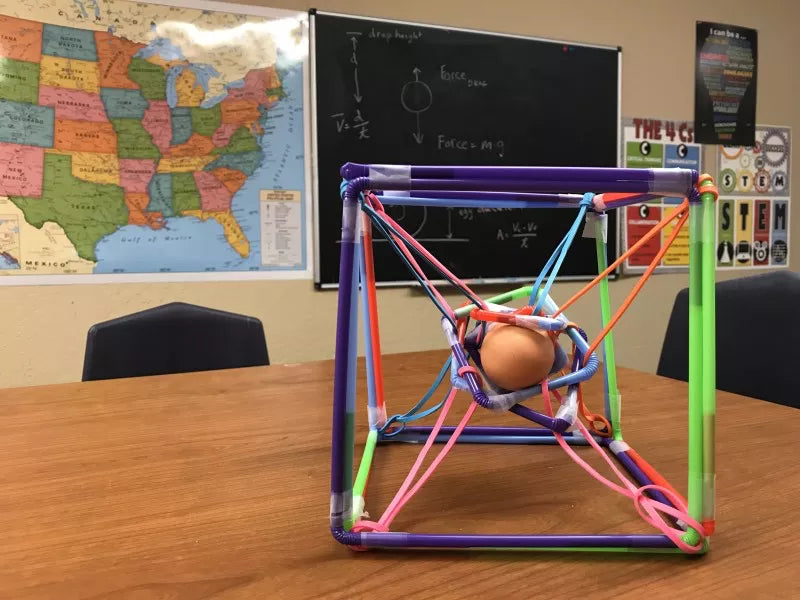
As you can see, this project requires your child to explore physics and engineering while they're having fun designing unique contraptions.
What equipment do you need?
Since the egg drop project is highly flexible, there are no set requirements for tools and materials. Depending on what you have in your house or classroom, you can use the following items:
- An egg
- Straws
- Cardboard tubes
- Rubber bands
- Paper
- Tape
- Craft sticks
- Paper towels
How is this useful to kids?
This STEM challenge helps you teach kids about potential energy, kinetic energy, and momentum. It's also a brilliant way to stimulate creativity because it requires young engineers to brainstorm unique solutions and think of different ways to use the materials they have.
Lastly, popular STEM projects like this one are particularly relatable to children.
Many YouTubers and online creators have tackled the egg drop challenge, making it exciting and approachable to kids. So, you could also watch a video or two together and see if there are any cool ideas you can borrow or improve.
Idea #4: Create a paper chain
Sometimes, less is more when it comes to STEM activities for kids, and the paper chain project exemplifies that principle perfectly.

As the name suggests, the paper chain project involves using strips of paper to create chains, and it might seem more like arts and crafts than science. However, this deceptively simple project offers valuable STEM learning opportunities in a fun and approachable way.
What equipment do you need?
To start, head over to your stationery drawer and grab the following supplies:
- Scissors
- Glue
- Paper
And that's all!
How is this useful to kids?
If you want a uniform chain, you'll need to measure pieces of paper carefully, introducing young ones to basic concepts of measurement and precision.
They also get to explore how different paper widths impact the strength and length of their chains. This is an excellent opportunity to show the children that math is absolutely everywhere around us.
Additionally, the fact that the activity is so simple also means that you can upgrade it however you like.
For instance, you can challenge your kids to make the longest paper chain possible with just one sheet of paper. Doing so will make them think of different ways to cut, fold, and link the strips to maximize the length of the chain.
Idea #5: Do a coding challenge
Let's not forget what the T stands for in STEM! To nudge your kid in the direction of technology, you can suggest playing around with programming. The simplest way to do this is with block code, which introduces little ones to the basics of coding without complex syntax.
If you're looking for a specific suggestion, we recommend Scratch, a visual programming language.
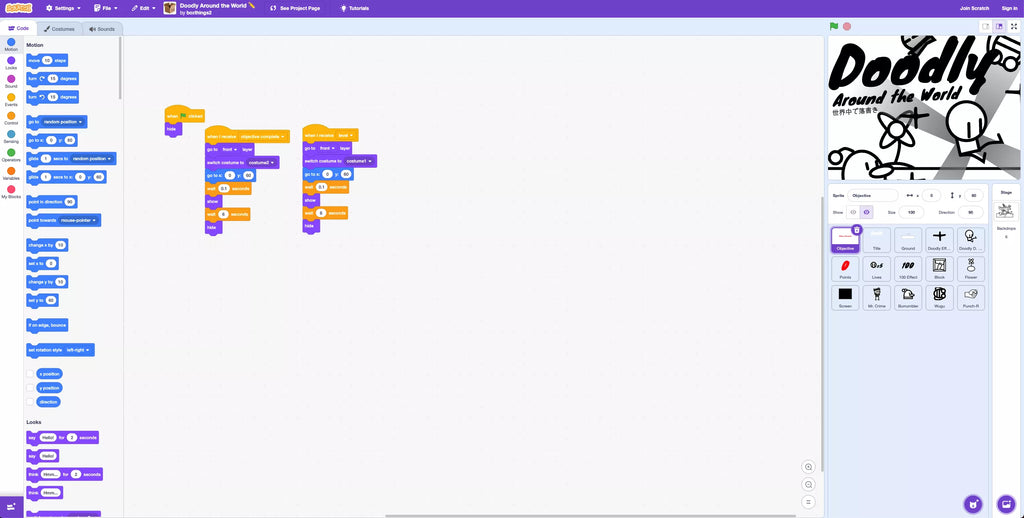
Programming in Scratch is truly a no-prep activity because you don't have to install anything; the platform runs in most desktop browsers. Also, it's completely free.
What equipment do you need?
Instead of stationery, this activity requires you to have access to:
- A computer
- An internet connection
How is this useful to kids?
Kid-friendly programming languages like Scratch boost digital literacy, which is an important aspect in every kid's education and, ultimately, career. Such STEM activities also encourage persistence because assembling code often involves refining, even with coding blocks.
Lastly, they foster creativity, as kids can create and customize their own coding adventures.
Idea #6: Light refraction experiment
Exploring light refraction is a STEM activity that your kid is inevitably going to cover in their physics class one day, and there's no reason why you couldn't get a head start at home.
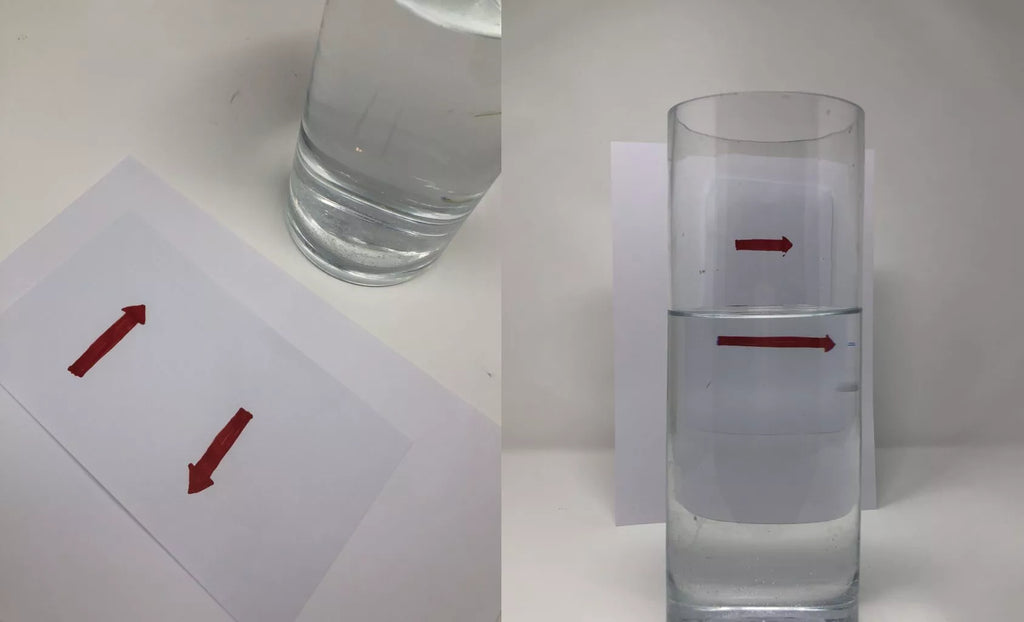
This experiment lets children discover how light bends, or refracts, when it passes from one medium to another, such as from air to water.
What equipment do you need?
You'll need the following items:
- A round glass
- Water
- Paper
- A felt-tip pen
How is this useful to kids?
Watching how an arrow looks like it's changed its direction when viewed through water helps little ones develop their observation and inquiry skills.
No matter how straightforward the experiment is, it's still a great way of introducing kids to physics concepts in a simple manner, laying the foundation for more advanced physics principles.
Idea #7: Create a paper airplane
Whether you're looking for a simple, three-minute project, or a complex process that challenges your kid's creativity and engineering skills, creating a paper airplane is a fun STEM activity for kids of all ages.
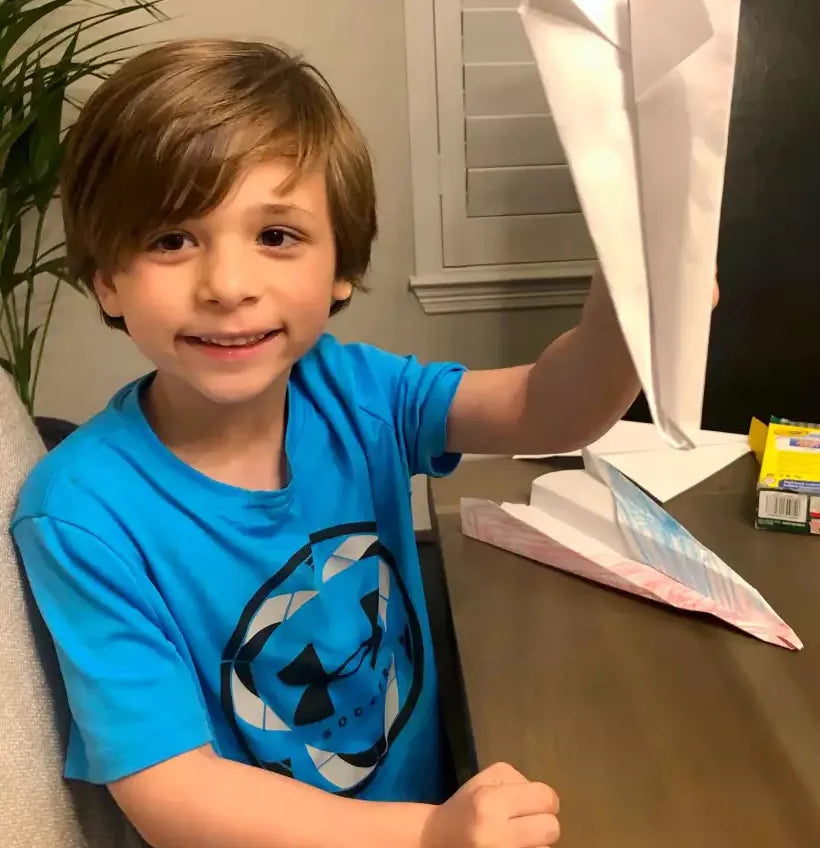
While younger aviators will probably stick to the basic dart shape, older kids can experiment with more advanced designs, and even come up with their own unique models.
What equipment do you need?
Brace yourself; here's a monstrously long list of hard-to-procure supplies you need for this project:
- Paper
On a serious note, you really only need paper to build planes. You can add an artistic flair to your creations with stickers, but bear in mind that these will add some weight and make the plane crash sooner.
How is this useful to kids?
Playing with different plane shapes and sizes introduces kids to fundamental principles of aerodynamics. Testing different plane variations will also teach them about lift, thrust, weight, and drag—the essential principles of flight.
How to prep younger kids for these no-prep STEM activities?
As promised, you don't have to run to a crafts store for any of these STEM activities for kids; you already have all the materials. However, there are steps that you can take to prepare your child for a meaningful learning experience.
- Choose those STEM activities that match your child's age and skill level.
- Set up a distraction-free environment for experimenting. It helps if you and your child areoff the phone, too.
- Explain the goals in simple terms. For instance, you can say: "We are going to make a paper airplane that can fly far. We will use different shapes and folds to make it aerodynamic, which means it can move smoothly through the air."
- Praise effort. Completing a task, even a simple one, can be a big deal for a young child.
Following these steps will help ensure a positive experience that shows that STEM is fun, exciting, and rewarding.
Of course, participating in activities together can also help you strengthen the relationship you have with your little ones.
Get your kids into STEM with CircuitMess
Once you've tried out all of these STEM activities, it may be the time to move on to more advanced concepts.
However, we've prepared even more cool DIY science projects and engineering endeavors you can take on with your young ones.
Now, you're reading an article on no-prep STEM activities, so we believe you'd like to maintain the same, practical approach even with bigger projects. That's why you should check out what CircuitMess has to offer.
We create fun educational kits for curious little minds. Wacky Robots are perfect intro to electronics for ages 9–11, while older children can try their hand at building simple yet powerful machines with the STEM Box subscription.
Each subscription line comes with all the components you need to build cool devices, such as a DIY smartwatch, a game console, a robotic arm, and more.
Whatever kit you choose, your child is guaranteed an engaging STEM activity and, of course, loads of fun.
Read stories how our founder Albert turned his childhood passion into CircuitMess, and get exciting DIY project ideas you can do with your kids at home for free.
Read more

What is STEM? A Fun and Future-Focused Way to Learn
The future demands adaptable and innovative minds. This guide breaks d...

Is Your Child Ready to Become a Space Explorer? (Here's How)
Your portal to space exploration. Build robots, code games, and unlock...

DIY Delights: 5 Easy Electronics Projects for Kids
Join thousands of parents inspiring their kids with these 5 easy elect...
